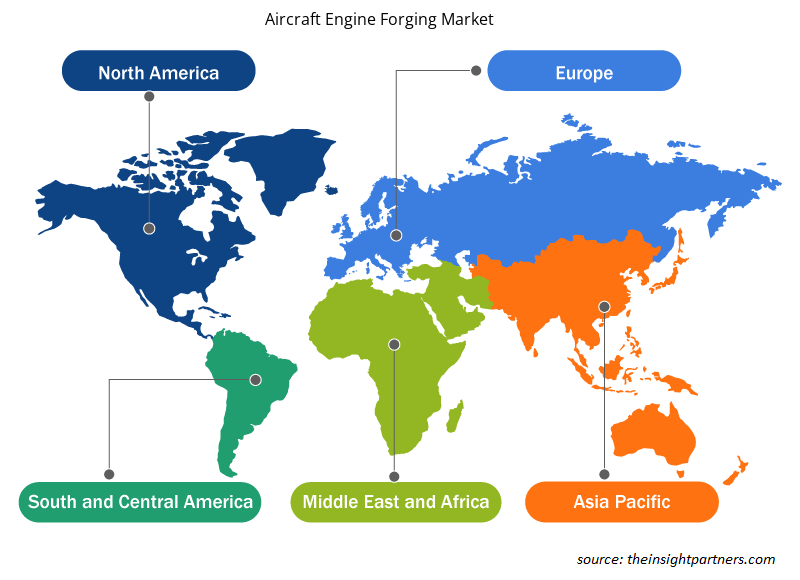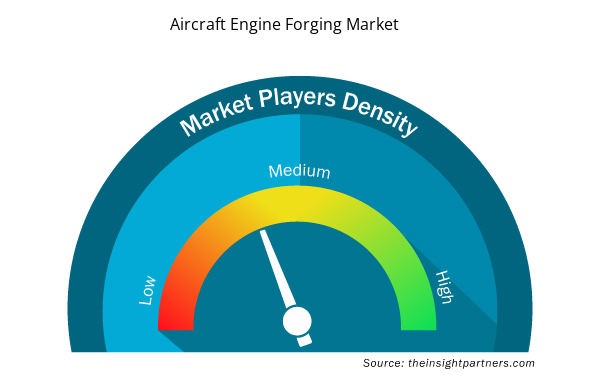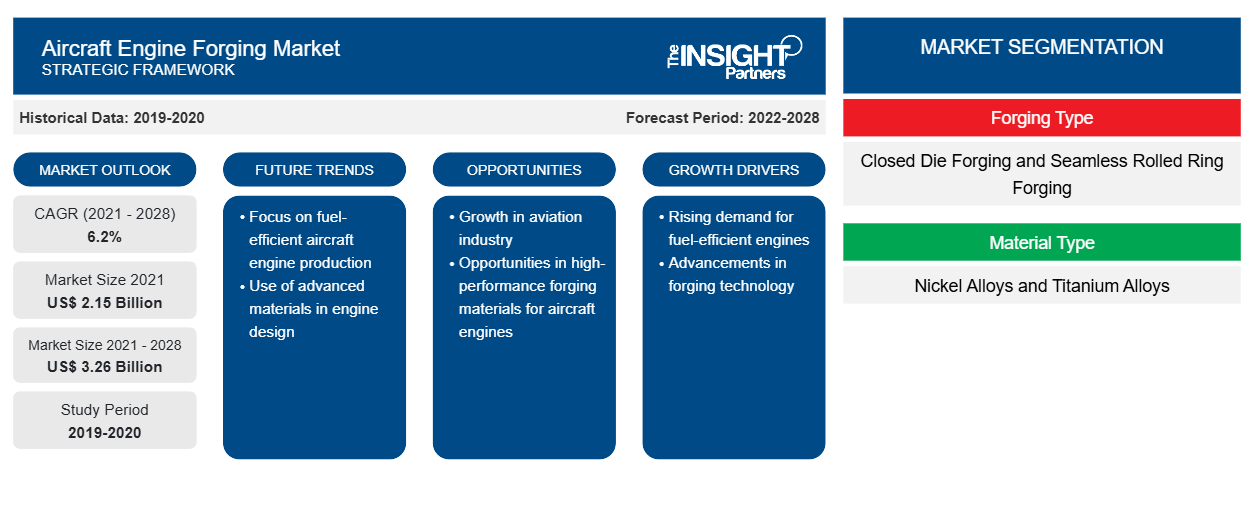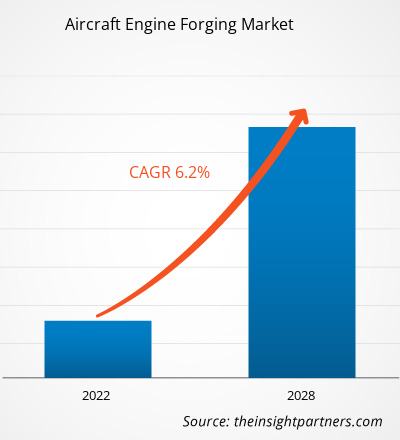Der Markt für Flugzeugtriebwerksschmieden soll von 2.145,80 Millionen US-Dollar im Jahr 2021 auf 3.260,77 Millionen US-Dollar im Jahr 2028 anwachsen; von 2021 bis 2028 wird mit einer durchschnittlichen jährlichen Wachstumsrate von 6,2 % gerechnet.
Nach Angaben der International Air Transport Association wird sich die Zahl der Fluggäste in den nächsten zwei Jahrzehnten voraussichtlich vervierfachen. Bis 2037 werden voraussichtlich etwa 8,2 Milliarden Passagiere mit dem Flugzeug gereist sein. Angesichts des steigenden Passagieraufkommens rechnen große Flugzeughersteller wie Airbus und Boeing in den kommenden Jahren mit einer Steigerung der Auslieferungen kommerzieller Flugzeuge. Ein Anstieg des Fluggastaufkommens in verschiedenen Ländern ist also ein wichtiger Faktor für den Markt für Flugzeugtriebwerksschmieden . Darüber hinaus steigt die Flugzeugproduktionskapazität als Reaktion auf den Anstieg des Flugverkehrs und die Einführung von Flugzeugen der nächsten Generation weiter an. Der Anstieg der Flugzeugherstellung würde dem Geschäft mit Flugzeugtriebwerksschmieden weiteren Auftrieb verleihen. Der Prozess des Schmiedens von Flugzeugtriebwerkskomponenten umfasst Metallbearbeitungs- und Bearbeitungstechniken wie Gesenkschmieden, nahtloses Gesenkschmieden und isothermes Schmieden.
Passen Sie diesen Bericht Ihren Anforderungen an
Sie erhalten kostenlos individuelle Anpassungen an jedem Bericht, einschließlich Teilen dieses Berichts oder einer Analyse auf Länderebene, eines Excel-Datenpakets sowie tolle Angebote und Rabatte für Start-ups und Universitäten.
- Holen Sie sich die wichtigsten Markttrends aus diesem Bericht.Dieses KOSTENLOSE Beispiel umfasst eine Datenanalyse von Markttrends bis hin zu Schätzungen und Prognosen.
Auswirkungen der COVID-19-Pandemie auf den Markt für Flugzeugtriebwerksschmieden
Die USA waren 2020 und 2021 von den schlimmsten Auswirkungen von COVID-19 betroffen. Die Hersteller von Flugzeugtriebwerken und Triebwerkskomponenten im Land waren aufgrund landesweiter Lockdowns und Reisebeschränkungen, der Schließung von Produktionsstätten und eines Mangels an Mitarbeitern betroffen. Der massive Ausbruch des Virus hat in den USA sowohl eine Gesundheitskrise als auch eine Wirtschaftskrise ausgelöst. Er hat zu erheblichen Störungen in der Luft- und Raumfahrtindustrie geführt und sich auf alles ausgewirkt, von der Lieferkette über die Fertigung bis hin zum Produktverkauf. Die Pandemie hat die kurzfristigen und langfristigen Strategien der Branche direkt und indirekt beeinflusst.
Markteinblicke – Markt für Flugzeugtriebwerksschmieden
In Nordamerika ist die Nachfrage nach Flugzeugtriebwerken aufgrund der frühen und schnellen Einführung technologisch fortschrittlicher Flugzeugtriebwerke gestiegen. Das boomende Luft- und Raumfahrtgeschäft sowie die Rüstungsindustrie in der Region ermutigen die Hersteller von Flugzeugtriebwerken, technologisch innovative und effiziente Produkte für verschiedene Flugzeugtypen anzubieten. Die Flugzeugtriebwerksindustrie in Nordamerika wird wahrscheinlich durch die steigende Nachfrage nach diesen Triebwerken und die Präsenz mehrerer großer Wettbewerber angetrieben, darunter General Electric Company, Honeywell International Inc., Collins Aerospace und Pratt & Whitney. Diese Unternehmen betreiben intensive F&E-Aktivitäten, um ihre Produktlinien zu erweitern und Flugzeugtriebwerke mit technologisch verbesserten Systemen, Subsystemen und anderen Komponenten herzustellen. Somit unterstützt das Wachstum der Flugzeugtriebwerksindustrie das Wachstum des Marktes für Flugzeugtriebwerksschmieden in ganz Nordamerika.
Materialtypbasierte Erkenntnisse
Basierend auf dem Materialtyp ist der Marktanteil von Flugzeugtriebwerksschmieden in Titanlegierungen und Nickellegierungen unterteilt. Die Nickellegierung hatte im Jahr 2020 den größten Anteil. Zahlreiche Schmiedeunternehmen, die in der Luft- und Raumfahrtindustrie tätig sind (unabhängig von Triebwerks- oder Strukturteilen), neigen eher zur Verwendung von Supernickellegierungen. Diese Materialien verfügen über hochtemperatur- und hitzebeständige Eigenschaften. Die Nickellegierungen werden in Gasturbinen für Gebäudeenergie, Schaufeln, Rotoren, Turbo- und Turbinenflugzeugtriebwerken, Dampfturbinen, Antriebsdüsen, Prozessausrüstung, Ventilen, Pumpen und anderen Teilen verwendet, die kritischen Umgebungen standhalten müssen. Nickellegierungen sind ideal für Umgebungen, in denen die Temperatur über 1000 Grad F liegt. Daher werden in einem Flugzeugtriebwerk Nickellegierungen in der Brennkammer und der Turbine verwendet. Da die Temperatur im hinteren Halbbereich hoch ist, wird in einem Flugzeugtriebwerk eine eisen- oder nickelbasierte Legierung verwendet. Die Nachfrage nach Nickellegierungen ist sowohl bei geschlossenen als auch bei offenen Gesenkschmiedetechniken extrem hoch. So hat beispielsweise Aubert & Duval vor Kurzem AD730 entwickelt. Dabei handelt es sich um eine neue Superlegierung auf Nickelbasis, die hohen Temperaturen von bis zu 1.350 °F standhält und gleichzeitig zu wettbewerbsfähigen Kosten Festigkeit, Dauerfestigkeit und Kriechverhalten aufweist.
Der Markt für Flugzeugtriebwerksschmieden ist nach Schmiedeart, Materialart, Endverbraucher und Geografie segmentiert. Nach Art ist der Markt für Flugzeugtriebwerksschmieden in Gesenkschmieden und nahtlos gewalzte Ringschmieden unterteilt. Nach Materialart ist der Markt in Nickellegierungen und Titanlegierungen unterteilt. Nach Endverbraucher ist der Markt weiter segmentiert in Lüftergehäuse, Brennkammeraußengehäuse, Turbinenscheibe, Rotoren und andere. Nach Geografie ist der Markt für Flugzeugtriebwerksschmieden hauptsächlich in Nordamerika, Europa, Asien-Pazifik (APAC), Naher Osten und Afrika (MEA) sowie Süd- und Mittelamerika segmentiert. All Metals & Forge Group, ATI Metals, Doncasters Group Ltd, Farinia Group, Lisi Aerospace, Otto Fuchs GmbH, Pacific Forge Incorporated und Precision Castparts Corp. gehören zu den Hauptakteuren, die während der Untersuchung des Marktes für Flugzeugtriebwerksschmieden profiliert werden.
Regionale Einblicke in den Markt für Flugzeugtriebwerksschmieden
Die regionalen Trends und Faktoren, die den Markt für Flugzeugtriebwerksschmieden im Prognosezeitraum beeinflussen, wurden von den Analysten von Insight Partners ausführlich erläutert. In diesem Abschnitt werden auch die Marktsegmente und die Geografie für Flugzeugtriebwerksschmieden in Nordamerika, Europa, im asiatisch-pazifischen Raum, im Nahen Osten und Afrika sowie in Süd- und Mittelamerika erörtert.

- Erhalten Sie regionale Daten zum Markt für Flugzeugtriebwerksschmieden
Umfang des Marktberichts zum Schmieden von Flugzeugtriebwerken
| Berichtsattribut | Details |
|---|---|
| Marktgröße im Jahr 2021 | 2,15 Milliarden US-Dollar |
| Marktgröße bis 2028 | 3,26 Milliarden US-Dollar |
| Globale CAGR (2021 - 2028) | 6,2 % |
| Historische Daten | 2019-2020 |
| Prognosezeitraum | 2022–2028 |
| Abgedeckte Segmente | Nach Schmiedetyp
|
| Abgedeckte Regionen und Länder | Nordamerika
|
| Marktführer und wichtige Unternehmensprofile |
|
Marktteilnehmerdichte: Der Einfluss auf die Geschäftsdynamik
Der Markt für Flugzeugtriebwerksschmieden wächst rasant, angetrieben durch die steigende Nachfrage der Endnutzer aufgrund von Faktoren wie sich entwickelnden Verbraucherpräferenzen, technologischen Fortschritten und einem größeren Bewusstsein für die Vorteile des Produkts. Mit steigender Nachfrage erweitern Unternehmen ihr Angebot, entwickeln Innovationen, um die Bedürfnisse der Verbraucher zu erfüllen, und nutzen neue Trends, was das Marktwachstum weiter ankurbelt.
Die Marktteilnehmerdichte bezieht sich auf die Verteilung der Firmen oder Unternehmen, die in einem bestimmten Markt oder einer bestimmten Branche tätig sind. Sie gibt an, wie viele Wettbewerber (Marktteilnehmer) in einem bestimmten Marktraum im Verhältnis zu seiner Größe oder seinem gesamten Marktwert präsent sind.
Die wichtigsten auf dem Markt für Flugzeugtriebwerksschmieden tätigen Unternehmen sind:
- Alle Metalle und Schmieden Gruppe
- ATI
- Doncaster Group Ltd
- Farinia-Gruppe
- Lisi Luft- und Raumfahrt
Haftungsausschluss : Die oben aufgeführten Unternehmen sind nicht in einer bestimmten Reihenfolge aufgeführt.

- Überblick über die wichtigsten Akteure auf dem Markt für Flugzeugtriebwerksschmieden
Die Akteure auf dem Markt für Flugzeugtriebwerksschmieden konzentrieren sich hauptsächlich auf die Entwicklung fortschrittlicher und effizienter Produkte.
- Im Jahr 2019 verkaufte Doncasters seine beiden Unternehmen mit Niederlassungen in Sheffield, Shrewsbury und Blaenavon. Blaenavon Forgings wird an die US-amerikanische Private-Equity-Firma Arlington Capital Partners und sein britisches Fabrications-Geschäft an Radius Aerospace verkauft.
- Im Jahr 2018 entwickelte LISI Aerospace in seinem Werk Forges de Bologne die Technologie des „Hot Die“-Schmiedens. Dieses neue Konzept trägt dazu bei, die Produktivität des konventionellen Schmiedens aufrechtzuerhalten und gleichzeitig eine metallurgische Qualität zu erreichen, die in Bezug auf die Homogenität der Mikrostruktur und die äußere Gesundheit der Teile der von isothermischen Schmiedestücken nahe kommt, d. h. einer Schmiedeanlage, die bei 1.250/1.300 °C betrieben wird.
- Historische Analyse (2 Jahre), Basisjahr, Prognose (7 Jahre) mit CAGR
- PEST- und SWOT-Analyse
- Marktgröße Wert/Volumen – Global, Regional, Land
- Branche und Wettbewerbsumfeld
- Excel-Datensatz


- Occupational Health Market
- Mice Model Market
- Water Pipeline Leak Detection System Market
- Vertical Farming Crops Market
- Electronic Signature Software Market
- Constipation Treatment Market
- Latent TB Detection Market
- Integrated Platform Management System Market
- Organoids Market
- Transdermal Drug Delivery System Market

Report Coverage
Revenue forecast, Company Analysis, Industry landscape, Growth factors, and Trends

Segment Covered
This text is related
to segments covered.

Regional Scope
North America, Europe, Asia Pacific, Middle East & Africa, South & Central America

Country Scope
This text is related
to country scope.
Häufig gestellte Fragen
The global aviation industry is experiencing huge demand for air travel, for both military and commercial purposes. This is leading the aircraft manufacturers to procure the latest aircraft models, and models and adopt new and robust technologies. Therefore, the production of the next generation of aircraft is expected to be one of the key trends in the aviation industry in the future. The trend is predicted to pitch over the period, leading to huge opportunities for the proliferation of aircraft component forging players
China dominated the APAC aircraft engine forging market in 2020. With a rising population in China, the adoption of air transportation is also growing. The plan of China related to the procurement of new helicopters is increased by 9%, which provides more opportunities to the engine forging companies. The aviation industry is among the top ten key areas of focus in the “Made in China 2025†initiative. To achieve this pre-determined goal, the country is heavily dependent on imported engines, avionics, and other critical components/parts. These ‘one-generation-behind’ new aircraft are projected to assist in the growth of China.
ATI Metals, Safran, Precision Castparts Corp., Arconic, and Otto Fuchs are the five key market players operating in the global aircraft engine forging market. We have derived this listing of “Key Five Players†in the global aircraft engine forging market by giving weightage to the following key parameters: overall revenue, segmental revenue, brand image & industry experience, current geotechnical construction services portfolio, customer base, geographical reach, partnerships, mergers & acquisitions, and other market-related activities.
The aircraft engine forging market is dominated by closed die forging segment which held a market share of 62.5% in 2020 and is anticipated to continue its dominance during the forecast period to account for 58.4% of the aircraft engine forging market share by 2028.
The rise in the manufacturing of aircraft is directly magnifying the demand for aircraft engines over years. Additionally, airlines, aircraft operators, armed forces, and charter operators are likely to boost the demand for new engines as part of their fleet modernization and growth plans. The growing need for a new generation of engines with low emissions and weight, which would improve airplane fuel efficiency, is also contributing to the aircraft engine forging market proliferation.
North America held the largest share of the global aircraft engine forging market. North America has experienced a rise in demand for aircraft engines due to the early and rapid adoption of technologically advanced airplane engines. The booming aerospace and defense aviation business in the region encourages aircraft engine manufacturers to provide technologically innovative and efficient products for various aircraft types. The aircraft engine industry in North America is likely to be driven by rising demand for these engines and the presence of several major competitors, including General Electric Company, Honeywell International Inc., Collins Aerospace, and Pratt & Whitney. These companies undertake vigorous R&D activities to expand their product lines and manufacture aircraft engines with technologically improved systems, subsystems, and other components. Thus, the growth of the aircraft engine industry is supporting the growth of the aircraft engine forging market across North America.
Trends and growth analysis reports related to Aerospace and Defense : READ MORE..
The List of Companies - Aircraft Engine Forging Market
- All Metals and Forge Group
- ATI
- Doncaster Group Ltd
- Farinia Group
- Lisi Aerospace
- Otto Fuchs GmbH
- Pacific Forge Incorporated
- Precision Castparts Corp.
- Safran
- VSMPO-AVISMA Corporation
The Insight Partners performs research in 4 major stages: Data Collection & Secondary Research, Primary Research, Data Analysis and Data Triangulation & Final Review.
- Data Collection and Secondary Research:
As a market research and consulting firm operating from a decade, we have published and advised several client across the globe. First step for any study will start with an assessment of currently available data and insights from existing reports. Further, historical and current market information is collected from Investor Presentations, Annual Reports, SEC Filings, etc., and other information related to company’s performance and market positioning are gathered from Paid Databases (Factiva, Hoovers, and Reuters) and various other publications available in public domain.
Several associations trade associates, technical forums, institutes, societies and organization are accessed to gain technical as well as market related insights through their publications such as research papers, blogs and press releases related to the studies are referred to get cues about the market. Further, white papers, journals, magazines, and other news articles published in last 3 years are scrutinized and analyzed to understand the current market trends.
- Primary Research:
The primarily interview analysis comprise of data obtained from industry participants interview and answers to survey questions gathered by in-house primary team.
For primary research, interviews are conducted with industry experts/CEOs/Marketing Managers/VPs/Subject Matter Experts from both demand and supply side to get a 360-degree view of the market. The primary team conducts several interviews based on the complexity of the markets to understand the various market trends and dynamics which makes research more credible and precise.
A typical research interview fulfils the following functions:
- Provides first-hand information on the market size, market trends, growth trends, competitive landscape, and outlook
- Validates and strengthens in-house secondary research findings
- Develops the analysis team’s expertise and market understanding
Primary research involves email interactions and telephone interviews for each market, category, segment, and sub-segment across geographies. The participants who typically take part in such a process include, but are not limited to:
- Industry participants: VPs, business development managers, market intelligence managers and national sales managers
- Outside experts: Valuation experts, research analysts and key opinion leaders specializing in the electronics and semiconductor industry.
Below is the breakup of our primary respondents by company, designation, and region:

Once we receive the confirmation from primary research sources or primary respondents, we finalize the base year market estimation and forecast the data as per the macroeconomic and microeconomic factors assessed during data collection.
- Data Analysis:
Once data is validated through both secondary as well as primary respondents, we finalize the market estimations by hypothesis formulation and factor analysis at regional and country level.
- Macro-Economic Factor Analysis:
We analyse macroeconomic indicators such the gross domestic product (GDP), increase in the demand for goods and services across industries, technological advancement, regional economic growth, governmental policies, the influence of COVID-19, PEST analysis, and other aspects. This analysis aids in setting benchmarks for various nations/regions and approximating market splits. Additionally, the general trend of the aforementioned components aid in determining the market's development possibilities.
- Country Level Data:
Various factors that are especially aligned to the country are taken into account to determine the market size for a certain area and country, including the presence of vendors, such as headquarters and offices, the country's GDP, demand patterns, and industry growth. To comprehend the market dynamics for the nation, a number of growth variables, inhibitors, application areas, and current market trends are researched. The aforementioned elements aid in determining the country's overall market's growth potential.
- Company Profile:
The “Table of Contents” is formulated by listing and analyzing more than 25 - 30 companies operating in the market ecosystem across geographies. However, we profile only 10 companies as a standard practice in our syndicate reports. These 10 companies comprise leading, emerging, and regional players. Nonetheless, our analysis is not restricted to the 10 listed companies, we also analyze other companies present in the market to develop a holistic view and understand the prevailing trends. The “Company Profiles” section in the report covers key facts, business description, products & services, financial information, SWOT analysis, and key developments. The financial information presented is extracted from the annual reports and official documents of the publicly listed companies. Upon collecting the information for the sections of respective companies, we verify them via various primary sources and then compile the data in respective company profiles. The company level information helps us in deriving the base number as well as in forecasting the market size.
- Developing Base Number:
Aggregation of sales statistics (2020-2022) and macro-economic factor, and other secondary and primary research insights are utilized to arrive at base number and related market shares for 2022. The data gaps are identified in this step and relevant market data is analyzed, collected from paid primary interviews or databases. On finalizing the base year market size, forecasts are developed on the basis of macro-economic, industry and market growth factors and company level analysis.
- Data Triangulation and Final Review:
The market findings and base year market size calculations are validated from supply as well as demand side. Demand side validations are based on macro-economic factor analysis and benchmarks for respective regions and countries. In case of supply side validations, revenues of major companies are estimated (in case not available) based on industry benchmark, approximate number of employees, product portfolio, and primary interviews revenues are gathered. Further revenue from target product/service segment is assessed to avoid overshooting of market statistics. In case of heavy deviations between supply and demand side values, all thes steps are repeated to achieve synchronization.
We follow an iterative model, wherein we share our research findings with Subject Matter Experts (SME’s) and Key Opinion Leaders (KOLs) until consensus view of the market is not formulated – this model negates any drastic deviation in the opinions of experts. Only validated and universally acceptable research findings are quoted in our reports.
We have important check points that we use to validate our research findings – which we call – data triangulation, where we validate the information, we generate from secondary sources with primary interviews and then we re-validate with our internal data bases and Subject matter experts. This comprehensive model enables us to deliver high quality, reliable data in shortest possible time.


 Holen Sie sich ein kostenloses Muster für diesen Bericht
Holen Sie sich ein kostenloses Muster für diesen Bericht